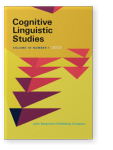Vol. 10:1 (2023) ► pp.85–98
Are metaphorical classes essentially abstract?
This article compares abstract concepts and metaphorical classes in order to emphasize the abstract nature of metaphorical classes. Sam Glucksberg (2003) used the expression “abstract superordinate categories” to refer to metaphorical classes. Drawing on this proposal and George Lakoff & Mark Johnson’s (1980) conceptual metaphor theory, this article suggests that metaphorical classes and abstract concepts share three essential features: (1) members of abstract concepts and metaphorical classes are highly diverse and heterogeneous; (2) both metaphorical classes and abstract concepts are highly reliant on situations and culture; (3) both metaphorical classes and abstract concepts are reliant on semantic associations and external concepts rather than intrinsic properties. Therefore, it may be claimed that metaphorical classes are a special group of abstract concepts with a special type of behavior.
Article outline
- 1.Introduction
- 2.Abstract concepts
- 3.Metaphorical classes and abstract concepts
- 3.1Diversity and heterogeneity
- 3.2Dependence on situations and cultures
- 3.3Reliance on semantic associations and external concepts rather than intrinsic properties
- 4.Conclusion
- Acknowledgements
-
References
